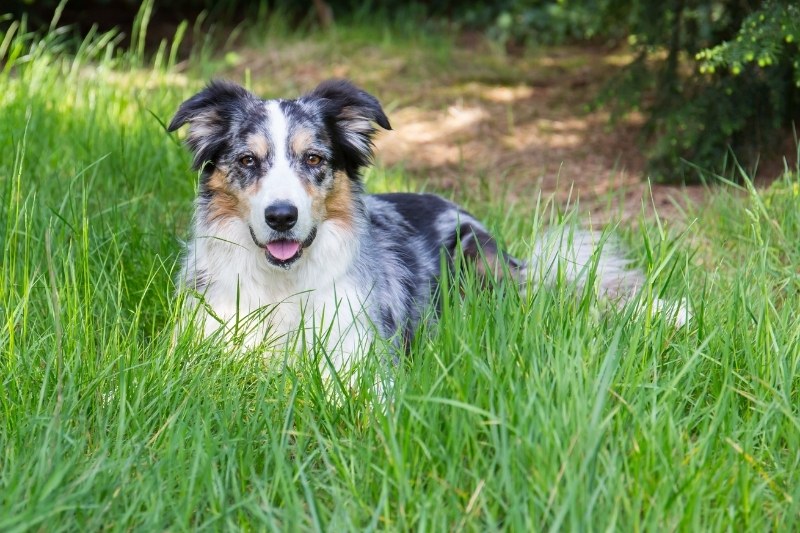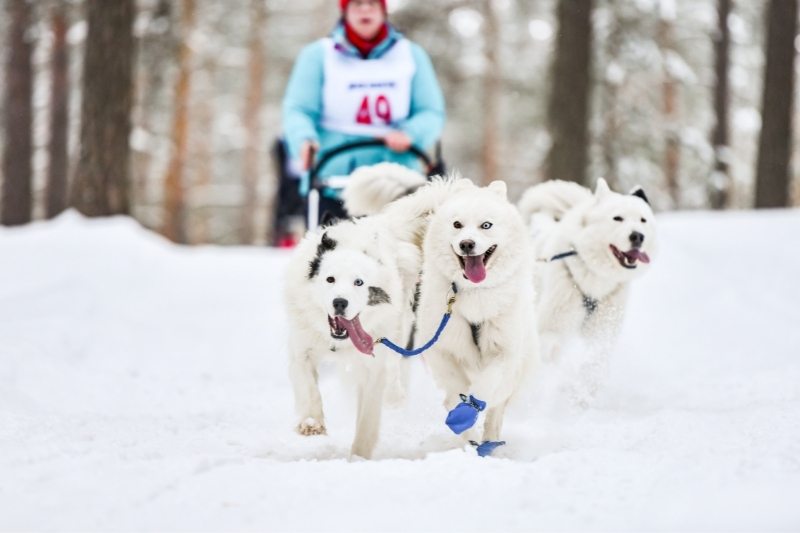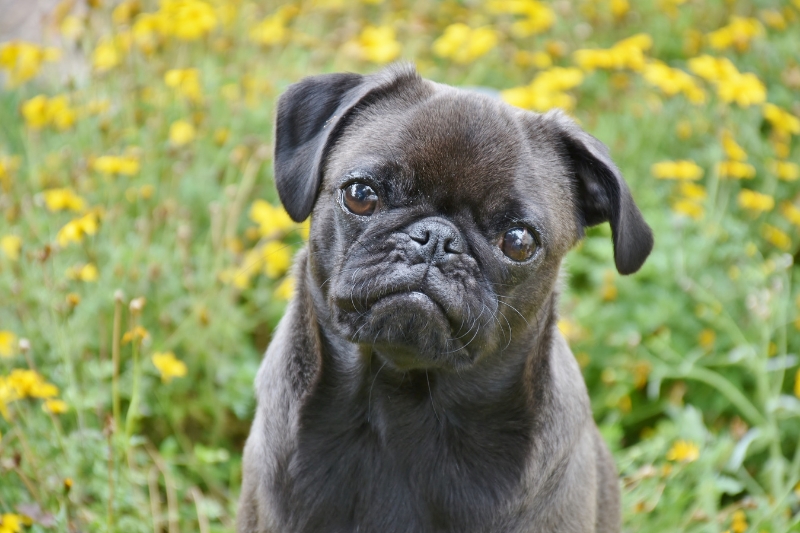20 Border Collie colors (with pictures!)

Border Collies are highly intelligent, energetic, and loving black and white dogs. Right? Well, partly. They're one of the smartest, if not the smartest dog breed in the world, have bundles of energy, and love to spend time with their family.
But they're not only black and white (although this is the most common color). There are actually many Border Collie Colors! Off the top of your head, how many can you think of?
Why type of coat does a Border Collie have?
As well as being a possible 24 colors, Border Collies also have 2 different types of coat – rough and smooth. Both coat versions are double coats (meaning they have a soft, downy undercoat and a coarser outer coat).
Rough coated Border Collies have a medium-length coat that can be feathered and a little fluffier on the legs, belly, and chest. Borders with smooth coats have shorter hair all over the body and barely any feathering.
Do all kennel clubs recognize the same Border Collie colors?
The different kennel clubs vary a little when it comes to accepted Border Collie colors. Here are the accepted colors of a few of the major ones:
- American Kennel Club: The AKC recognizes 17 different standard colors for these dogs. They are: black, blue, blue merle, brindle, gold, lilac, red, red merle, sable, sable merle, saddleback sable, white and black, white and blue, white and blue merle, white and red, white and red merle, and white ticked. The non-standard Border Collie colors are: seal, slate, white and gold, white and sable, and white and seal.
- Canadian Kennel Club: According to the CKC, a variety of coat colors are permissible. White, however, should never be the dominant coat color.
- United Kennel Club: Black and red are the most common colors. Less predominant colors include gray, blue merle, red merle, lemon, and sable. Border Collies may only have white trim and may have tan points.
All 20 Border Collie Coat Colors
These are many of the possible colors your Border Collie could have. Some are more common than others, but all are seriously beautiful!
Black and white Border Collie

Of course, the first on the list has to be the most iconic Border Collie color. When most people think of this dog they think of this beautiful color combination. Their bodies are normally black with white markings on their bellies and face. Black is the dominant gene in this coloring which makes it a standard for a Border Collie.
Black Border Collie
Fully black Border Collies are very rare, in fact, some breeders debate whether they exist at all. Black Border Collies, however, can have white markings – but this isn't the same as a black and white Border Collie. Keeping up?
Black and white Border Collies are a mixture of both colors, but black Border Collies are predominantly black and may have small, white patches on their chest, tail, legs, and face.
Black tri-color Border Collie
After black and white Border Collies, perhaps the next most popular are these black tri-colored dogs. They mainly have black bodies with white markings (similar to black and white Collies) but with tan-colored markings on their legs, chest, tails, and cheeks. They can also have adorable tanned eyebrows!
Tri-color is a recessive trait which means that two copies of the gene have to be present for a Border Collie to have this coloring.
Blue and white Border Collie
Blue Border Collies are genetically black and white but they also have the dilute gene which makes the black parts gray instead. Their coloring can range from light gray to such a dark gray it almost appears black.
For a Border to have this coloring, both the parent dogs must carry the dilute gene (they need two copies). There is some controversy over breeding pups with blue coloring as they can suffer from color dilution alopecia.
Blue Merle Border Collie
A blue merle Border Collie is a particularly good-looking dog. They're so unusual!
Their unique coat is normally a faded gray color with black/blue patches. The merle gene is a dominant modifying gene so these dogs will have the same coloring all over their bodies. Because the gene is dominant, these pups only need one copy (one parent with the gene) to have this stunning colored coat.
The merle gene doesn't just affect the coat color – it also affects their nose and eye color. Blue merle Border Collies tend to have light-colored eyes (such as bright blue which makes them look even better) and a pinkish nose.
If you're after one of these popular but rare Border Collie puppies, it's important to do your research so you know they've been ethically bred. Dogs that have two copies of the merle gene can suffer from many health problems such as blindness and deafness so it's important they just have one.
Blue tri Border Collie
Just like the blue merle Border Collie, a blue tri Border Collie will have the same overall basecoat color but with tan or copper markings on its face, chest, back, and eyebrows. These pups are truly beautiful and very sought after.
As with other merle pups, these dogs will have one copy of the dominant merle gene but two of the tri-colored gene.
Red Border Collie
Red Border Collies can appear in all sorts of different shades. Some are very dark and almost look brown, and others are so light they could be considered gold/cream.
Red is a recessive gene and two copies of it are needed to create a red Border. Two red Border Collies will give you a litter with many red puppies. This is a very attractive and popular color for Border Collies.
Red merle Border Collie
A red merle Border Collie will have a red base coat with white and dark-colored markings across its body. These dogs are really unusual and not that common. Just like other merle breeds, they're likely to have lighter-colored eyes, noses, and paws.
Gold Border Collie
These beautiful colored Border Collies don't actually look that much like Border Collies. In fact, some liken them more to Golden Retrievers! They can also be called Australian Reds and are considered fairly rare.
These pups carry a specific trait which is the dilution of their red coats which is recessive. Golden Border Collies come in many different shades and can be a light, golden caramel color to dark gold.
Chocolate and white Border Collie
This beautiful chocolate color is also a recessive gene which means that both parents must have a copy of the chocolate gene to have puppies with this coat color. Some dogs will have a very light chocolate-colored coat, and others a darker and richer one.
As with the black and white Border Collie, these pups will have white markings on their face, chest, and collar.
Something that makes these pups so attractive is their eye color. Their eyes can be yellow, gold, a kind of green, or light brown.
Chocolate tri-color Border Collie
Chocolate tri-colored Border Collies are beautiful, very cute dogs. They have the same base coat as a chocolate and white pup but can also have tan or copper markings on their face (sometimes eyebrows), legs, tail, and chest.
To breed a chocolate tri-colored pooch, both parents need to have the recessive chocolate gene and the tri-colored gene.
Lilac Border Collie
All lilac dogs are especially cute and unique looking. Is it blue? Gray? Brown? Their coats seem to change depending on how the sun hits and it's so beautiful!
To produce a lilac Border Collie puppy, both parents need to have the recessive chocolate and dilute gene – so as you can imagine, they're very rare. Their coat markings can be similar to the chocolate and white Border Collie but because they have the dilute gene, the chocolate color appears more gray (or lilac).
In many breeds (such as French Bulldogs), lilac is one of the most popular colors because it's so unique and interesting. It's important, however, to make sure you do your research and get your lilac Border Collie from a reputable breeder.
Lilac merle Border Collie
Merle is an incomplete coat pattern that has irregular patches with both diluted and solid color markings.
A lilac merle Border Collie may also have tan points on its body. A Border Collie that's lilac merle needs two copies of the tan gene as well as the recessive genes to create the lilac and merle markings.
So yes, they're very beautiful dogs but they're very hard to come by.
Brindle Border Collie
Brindle Border Collies can have any color base coat and darker stripes across their bodies which make them almost look like little tigers.
Some believe (although it's not true and has been proven not to be true by many breeders) that Border Collies can't naturally have a brindle coat. They think they must have been cross-bred with another breed.
The AKC, however, recognizes these pups as purebred and an official Border Collie color – so there really shouldn't be any controversy!
Sable Border Collie
Sable color is when a pup has lighter roots and the hairs get darker towards the tip. A sable Border Collie can look very different from another sable pup depending on the mix of colors in their coat. They are generally not very dark dogs.
Some sable pups may also have white markings on their bodies, particularly around the face and collar. A black, chocolate, lilac, and blue Border Collie can have the sable pattern.
Seal Border Collie
Seal Border Collies have an incomplete expression of the sable gene which can make them look very dark brown or even black.
They can have patches of lighter color which are very hard to notice. They have different colored tips (as per the sable coat pattern), but these can generally only be seen in sunlight. These tips are most noticeable on their shoulders and sides.
This is one of the rarest Border Collie colors.
Slate merle Border Collie
Slate merle Border Collies are really just a lighter-colored blue Border Collie. They look light gray. Blue coated Border Collies can also have the merle gene, which means that parts of the coat are lighter or darker than the rest.
A blue merle Border Collie with a lot of white can look very similar to a slate merle pup. But there is a way to tell them apart! A blue merle will have a black nose, and a slate merle will have a beautiful grey one!
Piebald Border Collie
A piebald Border Collie (or any piebald pup for that matter) is a primarily white dog with irregular and asymmetrical spots all over its body. Usually, the head is colored with darker markings or an entire color. If there's a lot of white on your Border's head (especially the ears), they may suffer from deafness.
Piebald can be on many different base colors, including black and white, red, and blue merle.
White ticked Border Collie
White ticked Borders have some black specks on their white markings around their face, chest, and collar. It almost looks as though they've been painted with a paintbrush! Although not desired by some who prefer a solid-colored dog, these pups are totally accepted by the AKC and other kennel clubs.
Saddleback sable Border Collie
Many find it difficult to identify a saddleback pup because they can look like sable or tri-colored pups. Usually, however, these dogs have sable colorings which don't cover their whole bodies but appear in larger patches that are separated by white fur. Saddleback sables usually have some tan on their face which can make them look tri-colored.
Border Collies are really popular family dogs. Not only are they super intelligent and adoring dogs, but they also come in way more colors than you might think!
On this list, there is a mix of the more unusual and more common Border Collie colors. Which is your favorite?
I’m Charlotte, a content and copywriter from the North of England and currently living in Berlin. Animals have always been a huge part of my life, so writing about dogs is a total pleasure! I love all kinds of dogs and their cheeky personalities, but I’d have to say Weimaraners are my favourite!








